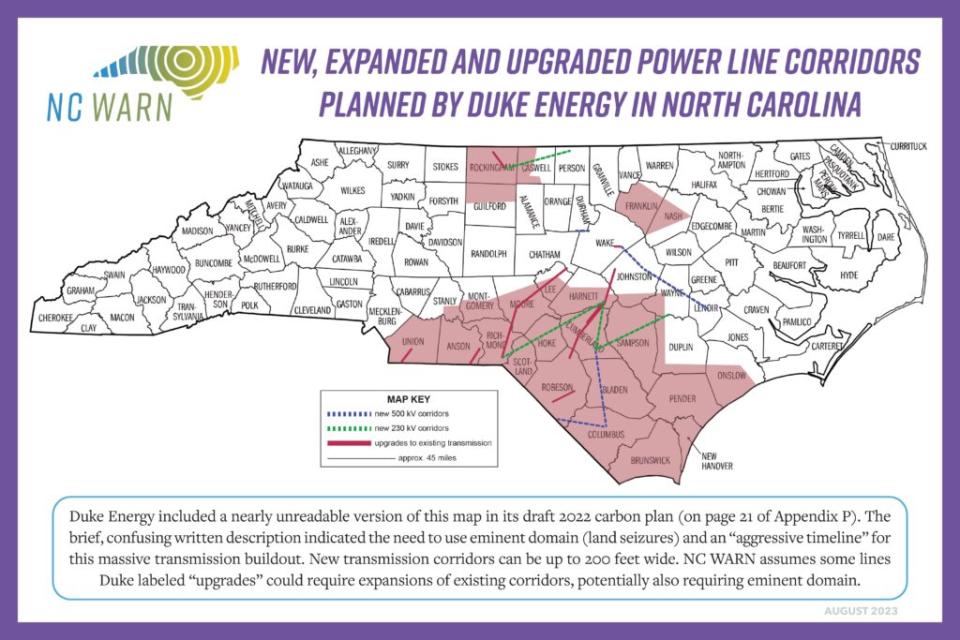NC must avoid a ‘bulldozer transition’ to solar energy

The author says that Duke Energy has plans to build profitable electric transmission lines in the transition to solar energy that would likely be unnecessary if it embraces widespread deployment of rooftop solar. (Photo by Brandon Bell/Getty Images)
North Carolinians concerned about climate change should know that Duke Energy is moving toward land confiscations in the state’s southeast on an “aggressive timeline.” The utility is poised to use solar projects in “red zones” as a pretext to build lucrative transmission projects, the land corridors of which would be cleared with eminent domain. Rural communities must be protected from this Duke Energy profit grab for moral and political reasons.
Duke Energy only wants one kind of solar — huge fields of panels in southeastern North Carolina on cheap land that the utility refers to as red zones. The “Portfolios” section of their Carolina Resource Plan [see page 3] calls for at least 11.8 gigawatts of utility-scale solar by 2035.
By contrast, the utility has long been opposed to rooftop solar, whereby panel owners can generate and sell their own electricity. Duke Energy’s anti-solar campaign scored a major win in March 2023 when the North Carolina Utilities Commission (NCUC) weakened net metering (NEM) policy, which had previously led to a surge in rooftop solar. The NEM decision has been challenged in court by NC WARN, a climate nonprofit.
There is another reason Duke Energy doesn’t like independent solar. If people and businesses install panels on rooftops, the power is generated very close to its point of use, reducing the need for transmission projects. On the other hand, if Duke Energy is allowed to build solar fields in southeast North Carolina, they can claim that new power lines are needed to transport the energy to population centers in the Triangle.
To understand why Duke Energy wants to build power lines, just look at how they make profit. For many projects, the utility has a state-backed guarantee [see page 157] of about 10 percent return on equity. When the NCUC gives Duke Energy permission to spend money on anything, the utility makes money. Such an incentive structure would perhaps be tolerable, though strange, if the NCUC had firm control over Duke Energy.
However, Duke Energy is a political juggernaut more than capable of ensuring a compliant NCUC. The utility has long been able to secure orders for unwise projects merely to juice their own profits. Transmission projects in southeast North Carolina are set to be a new, egregious case.
According to Duke Energy’s “Third Quarter 2022 Earnings Review and Business Update,” [see page 18] the utility plans to spend $75 billion on grid investments over the next 10 years. Duke Energy operates in many states, but a proportional allocation of the $75 billion to North Carolina would amount to tens of billions. The utility’s incentive structure and dislike of NEM have dovetailed to create a cynical opportunity for profit.
If the Duke Energy “land seizure and grid scheme” goes forward, all North Carolinians would be harmed, but not equally. A ratepayer living in Boone, for instance, would see their power bill rise and money wasted. However, many people in red zone communities like Whiteville, Rockingham, and Hope Mills could lose their homes and lands. Eminent domain would be needed to clear land corridors up to 200 feet wide.
Displacing rural communities for unnecessary transmission projects would be extremely unjust. Duke Energy would loudly claim that the land confiscations are the price of more renewable energy, risking huge political blowback against all green initiatives in North Carolina. Red zone victims of eminent domain could also become easy prey for climate change denying politicians and fossil fuel industry flaks who spread untruth and crazy conspiracy theories.
The climate movement has long stressed the need for a Just Transition, where green policies take impacted people’s interests into consideration. For example, although the fossil fuel industry must eventually come to an end, policies can and should be geared to ensure that impacted workers are trained for and obtain jobs in sustainable industries.
Instead of a Just Transition, Duke Energy and the NCUC are at risk of creating a Bulldozer Transition in southeastern North Carolina. People in the red zone deserve to be protected from the utility’s fraudulent and destructive plan.
The post NC must avoid a ‘bulldozer transition’ to solar energy appeared first on NC Newsline.


